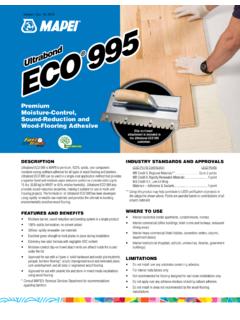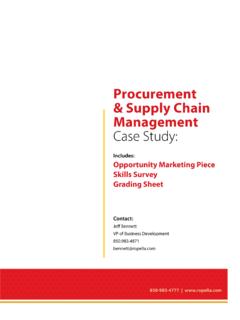Transcription of MAPEI KERALASTIC COMPONENT A - Allduro
1 MAPEI KERALASTIC COMPONENT AChemwatch Material Safety Data SheetCHEMWATCH 5044-39 Issue Date: Fri 1-Apr-2005CD 2005/3 Page 1 of 13 Section 1 - CHEMICAL PRODUCT AND COMPANY IDENTIFICATIONPRODUCT NAMEMAPEI KERALASTIC COMPONENT ASYNONYMS"polyurethane epoxy adhesive"PRODUCT USEBase or Part A of a 2 pack. urethane adhesive. Requires that the two parts bemixed by hand or mixer before use, in accordance with manufacturers only as much as is required. Do not return the mixed material to theoriginal containers. Refer also to protective measures for the other componentused with the product. Read both MSDS before using; store and attach : MAPEI Australia P/LAddress:12 Parkview DriveArcherfieldQLD, 4108 AUST elephone: +61 7 3276 5000 Fax: +61 7 3276 5076 Section 2 - HAZARDS IDENTIFICATIONSTATEMENT OF HAZARDOUS NATUREHAZARDOUS SUBSTANCE.
2 NON-DANGEROUS GOODS. According to theCriteria of NOHSC, and the ADG SCHEDULES5 RISKH armful by inhalation and in contact with to cause SENSITISATION by skin to aquatic organisms, may cause long-term adverse effects in the effects may result following exposure*.May produce discomfort of the eyes*.Limited evidence of a carcinogenic effect*.Possible respiratory sensitiser*.May be harmful to the foetus/ embryo*.May possibly affect fertility*.* (limited evidence).SAFETYKeep container in a well ventilated exposure - obtain special instructions before clean the floor and all objects contaminated by this material, use water and away from food, drink and animal feeding KERALASTIC COMPONENT AChemwatch Material Safety Data SheetCHEMWATCH 5044-39 Issue Date: Fri 1-Apr-2005CD 2005/3 Page 2 of 13 Section 2 - HAZARDS IDENTIFICATIONTake off immediately all contaminated case of contact with eyes, rinse with plenty of water and contact Doctor or Poisons Information swallowed, IMMEDIATELY contact Doctor or Poisons Information Centre.
3 (show this container or label).If you feel unwell contact Doctor or Poisons Information Centre. (Show the label if possible).Section 3 - COMPOSITION / INFORMATION ON INGREDIENTSNAMECAS RN%polyurethane resin 10-30bisphenol A/ epichlorohydrin resin, liquid25068-38-65-10fillers as calcium carbonate471-34-110-30talc14807-96-6xyle ne1330-20-7<5 Section 4 - FIRST AID MEASURESSWALLOWED Immediately give a glass of water. First aid is not generally required. If in doubt, contact a PoisonsInformation Centre or a this product comes in contact with the eyes: Wash out immediately with fresh running water. Ensure complete irrigation of the eye by keeping eyelids apart and away fromeye and moving the eyelids by occasionally lifting the upper and lower lids.
4 If pain persists or recurs seek medical attention. Removal of contact lenses after an eye injury should only be undertaken byskilled skin contact occurs: Immediately remove all contaminated clothing, including footwear Flush skin and hair with running water (and soap if available). Seek medical attention in event of If fumes or combustion products are inhaled remove from contaminated area. Other measures are usually TO PHYSICIANT reat 5 - FIRE FIGHTING MEASURESEXTINGUISHING MEDIA Foam. Dry chemical powder. BCF (where regulations permit). Carbon dioxide. Water spray or fog - Large fires KERALASTIC COMPONENT AChemwatch Material Safety Data SheetCHEMWATCH 5044-39 Issue Date: Fri 1-Apr-2005CD 2005/3 Page 3 of 13 Section 5 - FIRE FIGHTING MEASURESFIRE FIGHTING Alert Fire Brigade and tell them location and nature of hazard.
5 Wear breathing apparatus plus protective gloves. Prevent, by any means available, spillage from entering drains or watercourses. Use water delivered as a fine spray to control fire and cool adjacent area. DO NOT approach containers suspected to be hot. Cool fire exposed containers with water spray from a protected location. If safe to do so, remove containers from path of fire. Equipment should be thoroughly decontaminated after HAZARD Hot organic vapours or mist are capable of sudden spontaneous combustion whenmixed with air even at temperatures below their published autoignitiontemperatures. The temperature of ignition decreases with increasing vapour volume andvapour/air contact times and is influenced by pressure change.
6 Ignition may occur under elevated-temperature process conditions especially inprocesses performed under vacuum subjected to sudden ingress of air or inprocesses performed at elevated pressure, where sudden escape of vapours ormists to the atmosphere occurs. Combustible. Slight fire hazard when exposed to heat or flame. Heating may cause expansion or decomposition leading to violent rupture ofcontainers. On combustion, may emit toxic fumes of carbon monoxide (CO). May emit acrid smoke. Mists containing combustible materials may be explosive., Combustion productsinclude, carbon dioxide (CO2), aldehydes, other pyrolysis products typical ofburning organic emit poisonous emit corrosive INCOMPATIBILITYA void contamination with oxidising agents nitrates, oxidising acids,chlorine bleaches, pool chlorine etc.
7 As ignition may Protective EquipmentPERSONAL PROTECTION EQUIPMENTB reathing tight chemical resistant exposure duration to 1 BA set - 30 6 - ACCIDENTAL RELEASE MEASURESEMERGENCY PROCEDURESMINOR SPILLS Clean up all spills immediately. Avoid contact with skin and eyes. Wear impervious gloves and safety goggles. Trowel up/scrape up. Place spilled material in clean, dry, sealed container. Flush spill area with water. Clean up all spills KERALASTIC COMPONENT AChemwatch Material Safety Data SheetCHEMWATCH 5044-39 Issue Date: Fri 1-Apr-2005CD 2005/3 Page 4 of 13 Section 6 - ACCIDENTAL RELEASE MEASURES Avoid breathing vapours/ aerosols or dusts and avoid contact with skin andeyes. Place in a suitable labelled container for waste SPILLSM inor hazard.
8 Clear area of personnel. Alert Fire Brigade and tell them location and nature of hazard. Control personal contact by using protective equipment as required. Prevent spillage from entering drains or water ways. Contain spill with sand, earth or vermiculite. Collect recoverable product into labelled containers for recycling. Absorb remaining product with sand, earth or vermiculite and place inappropriate containers for disposal. Wash area and prevent runoff into drains or waterways. If contamination of drains or waterways occurs, advise emergency EXPOSURE LIMITSM aterialRevised IDLHR evised IDLHV alue (ppm)Value (mg/m3)Talc1,000 Xylene (o, m, p isomers)900 EMERGENCY RESPONSE PLANNING GUIDELINES (ERPG)The maximum airborne concentration below which it is believed that nearly allindividuals could be exposed for up to one hour WITHOUT experiencing or developinglife-threatening health effects is:bisphenol A/ epichlorohydrin resin, liquid500 mg/m calcium carbonate500 mg/m irreversible or other serious effects or symptoms which couldimpair an individual's ability to take protective action is.
9 Bisphenol A/ epichlorohydrin resin, liquid50 mg/m calcium carbonate50 mg/m other than mild, transient adverse effectswithout perceiving a clearly defined odour is:bisphenol A/ epichlorohydrin resin, liquid30 mg/m calcium carbonate30 mg/m The threshold concentration below which most experience no appreciable risk of health effects:bisphenol A/ epichlorohydrin resin, liquid10 mg/m calcium carbonate15 mg/m American Industrial Hygiene Association (AIHA)Ingredients considered according exceed the following cutoffsVery Toxic (T+) >= (T)>= >= (C)>= >= >= 10%where percentage is percentage of ingredient found in the mixturePersonal Protective Equipment advice is contained in Section 8 of the KERALASTIC COMPONENT AChemwatch Material Safety Data SheetCHEMWATCH 5044-39 Issue Date: Fri 1-Apr-2005CD 2005/3 Page 5 of 13 Section 7 - HANDLING AND STORAGEPROCEDURE FOR HANDLING Avoid all personal contact, including inhalation.
10 Wear protective clothing when risk of exposure occurs. Use in a well-ventilated area. Prevent concentration in hollows and sumps. DO NOT enter confined spaces until atmosphere has been checked. DO NOT allow material to contact humans, exposed food or food utensils. Avoid contact with incompatible materials. When handling, DO NOT eat, drink or smoke. Keep containers securely sealed when not in use. Avoid physical damage to containers. Always wash hands with soap and water after handling. Work clothes should be laundered separately. Launder contaminated clothingbefore re-use. Use good occupational work practice. Observe manufacturer's storing and handling recommendations. Atmosphere should be regularly checked against established exposure standardsto ensure safe working conditions are CONTAINER Metal can or drum Packaging as recommended by manufacturer.





